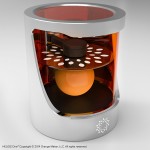
We’ve just passed the stage where 3D printers themselves were exotic devices of magic and wonder, and now individual types of 3D printers are exotic devices of magic and wonder. To wit: Orange Maker.
This stereolithographic (SLA) printer is fairly standard – a UV light shoots through a special liquid which hardens into an object. However, thanks to a spinning print base, the printer can produce objects much faster than regular printers.
What is the primary difference? SLA printers like Form 1 shoot out a layer of the print and then “tilt” the tank to remove excess liquid. This brief operation slows down the printing process considerably. By turning the object as it’s made, you reduce the amount of time necessary to slough off the excess fluid.
Created in 2011 by Kurt Dudley, Doug Farber, and Chris Marion, the team has backgrounds in engineering and art. The device, as rendered, looks pretty cool and the spinning process, shown in the video below, makes sense when you think about the motions necessary to print and “peel” the parts as they’re built.
“Many of the other printer companies have repackaged 20+ year-old technology and are either held back from innovation by the industry giants, or utilize open-source technology,” said Dudley. “We designed our system to resolve the key issues facing current generation technology in a novel way that simultaneously expands its functionality.”
There is, arguably, very little information about the printer available. The company hasn’t talked about resolution or software and the price is still up in the air. They’ve also patented the concept of “Heliolithography” i.e. the spinning system they use and this could be more of a proof of concept than a product.
But the team expects to start selling the printers in 2015 and it will be interesting to see how they handle the issues of manufacturing, distribution, and support that have thus far hamstrung a number of promising 3D printing startups.
Source: Techcrunch.com